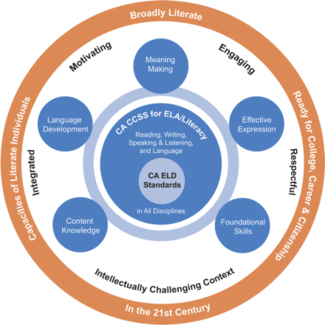History & Social Studies
2014-2016 Draft History-Social Science Framework Grades 6-8
Key Shifts and Concepts to the History-Social Science Framework
Disciplinary Thinking and Analysis Skills - The Historical and Social Science Analysis Skills and the C3 Framework address the intellectual skills students should learn and apply when engaged in inquiry in history-social science courses, grades six through eight.
Civics and Government - When studying civics and government, students explore how people participate in the governing of society. In middle school, these skills include students’ abilities to explain and distinguish the powers, roles, and responsibilities of citizens, government, and the media. Students should be able to explain the relevance of individual perspective, civic virtues, and democratic principles when people address issues and problems in government and civil society. Students analyze ideas and principles that influence social and political systems as well as the powers and limits of those systems. Additionally, students learn how to assess specific rules and laws as means of addressing public problems. Students develop the ability to apply civic virtues and democratic principles.
Economics - In order to make effective economic decisions, students need to understand how individuals, businesses, governments, and societies use human, physical, and natural resources. The economic reasoning skills that middle school students need include the ability to explain how economic decisions affect the well-being of individuals, businesses, and society. Students learn how to interpret basic indicators of economic performance and conduct cost-benefit analyses of economic and political issues. They should understand that people voluntarily exchange goods and services when both parties expect to gain as a result of the trade, that markets facilitate the exchange of goods and services, and that there are benefits and the costs of trade policies.
Geography -In studying geography, students explore local characteristics of places and learn about how places connect to each other. Middle-school students’ geographic reasoning skills include using maps, satellite images, photographs, and other representations to explain relationships between the locations of places and regions, and their different environmental and cultural features. Students
explain how the physical and human characteristics of places and regions are connected to human identities and cultures. They analyze how relationships between humans and environments affect settlement and movement, diffusion of ideas and cultural practices, and conflict and cooperation.
History - Historical thinking is a process of chronological reasoning, which means wrestling with issues of causality, connections, significance, perspectives, and context with the goal of developing credible arguments about the past based on reasoned interpretation of evidence from a variety of primary and secondary sources in diverse media formats. In middle school, students place events, ideas, and developments in historical context by considering the date, place, and other developments happening at the same time. They evaluate the relevancy, credibility, and utility of a historical source based on information such as author, date, place of origin, intended audience, and purpose. Students analyze multiple factors that influenced the perspectives of people during different historical eras and how and why they have changed over time. Students understand and distinguish cause, effect, sequence, and correlation in historical events, including the long-and short-term causal relations. Finally, students detect possible limitations in the historical record and recognize that interpretations of history are subject to change as new information is uncovered.
Literacy Skills - The CA CCSS for ELA/Literacy in History/Social Studies for grades six - eight are a big leap for students as they move from the elementary grades to the middle grades in all disciplines. Argument is introduced at grade six. Students move beyond stating reasons and evidence to tracing and evaluating arguments and claims in texts. They write their own arguments supported with relevant evidence and clear reasoning. The CA CCSS Literacy in History/Social Studies Reading and Writing Standards complement the History–Social Science Content Standards and help students grapple with primary and secondary sources they encounter.
Reading - In grades six through eight, the reading strand of the CCSS presents rigorous concepts of evidence, argumentation, and integration and analysis of multiple sources and perspectives. The reading standards for literacy in history/social studies direct students to cite specific textual evidence to support analysis of primary and secondary sources. Students must be able to describe how a text presents information and identify aspects of text that reveal author’s point of view. They must be able to distinguish among facts, reasoned judgments, opinions or speculation in a text; and analyze the relationship between a primary and secondary source.
Writing - In history–social science and the other content areas, students begin writing arguments about discipline-specific content by introducing claims and distinguishing them from opposing claims, supporting claims logically and with relevant and accurate data and evidence, and establishing and maintaining a formal style. They also write informative/ explanatory texts, including narration of historical events and processes, using relevant, well-chosen facts and appropriate and varied transitions.
Research - Opportunities to engage in research contribute to students’ history-social science content knowledge. The grade span skills for building content knowledge through research call for students to conduct short research projects to answer a question and generate additional related, focused questions for further research or that allow for multiple avenues of exploration. Students gather relevant information from multiple print and digital sources, assess the credibility of sources, quote or paraphrase data and conclusions of others, avoid plagiarism, provide basic bibliographic information, use search terms effectively, and follow a standard format for citation.

6-8 Social Studies Guides & Resources
iCivics: Play-Lead-Teach

Click on iCivics to engage in this enriching web-based education project designed to teach students civics and inspire them to be active participants in U.S. democracy.

History–Social Science Framework Second Field Review Draft
Approved by the Instructional Quality Commission November 20, 2015
Instructional Practice for Grades Six - Eight
In addition to providing history–social science content, teachers must emphasize disciplinary and literacy practices – investigation, close reading, analysis of evidence, and argumentative writing. The Historical and Social Science Analysis Skill Standards, the Common Core State Standards for English Language Arts and Literacy in History/Social Studies (CA CCSS for ELA/Literacy), and the California English Language Development Standards (CA ELD Standards) guide these practices in history-social science. Educators may also want to consider the College, Career, and Civic Life (C3) Framework, published in 2013 by the National Council for the Social Studies. All of these resources emphasize the need for students to think, read, and write in a discipline-specific way. The skills noted below are to be learned through, and applied to, the content standards for grades six through eight. They are also to be assessed with the content standards in these grades.
